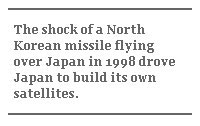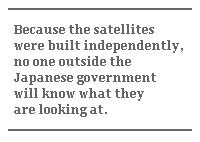Japan Joins the Exclusive Space Spy Club
Japan Joins the Exclusive Space Spy Club

As the US-led coalition is fighting in Iraq - significantly enabled by space-based surveillance and navigational systems - space-based capabilities are being enhanced in other theaters as well. With the US and neighbors of North Korea nervously watching Pyongyang's next move, Japan sent up a new pair of eyes to the sky to look for danger. A Japanese rocket blasted off from its Tanegashima island launch pad the morning of March 28, carrying two reconnaissance satellites. The North Korean response to the earlier launch announcement was a threat of "disastrous consequences," clearly indicating the import they place on Japan acquiring this new capability.
Officially described as multi-purpose information gathering satellites (IGS), they will "collect imagery information necessary to ensure [the] national security of Japan." Specifically, they will provide information for diplomatic and defense policy decision-making, as well as information to support crisis management and disaster relief situations. This is an important first step to establish an independent space-based surveillance and reconnaissance system and join the elite club of countries who can view the world from afar.
The initial IGS system will consist of two optical and two synthetic aperture radar (SAR) satellites, along with dedicated ground stations for satellite control, data collection, analysis and dissemination. In daylight, weather permitting, the optical satellites will take photos of up to 1-meter resolution. In cloudy weather or even darkness, the SAR radar imagery resolution is between 1 to 3 meters and can take pictures of objects as small as cars. Low altitude orbits means the satellites will pass over all points on Earth frequently and track developments almost as they happen.

What drove Japan to build these satellites? It was the shock of a North Korean missile flying over Japan. Although the Japanese defense establishment had prior warning from the US intelligence that it was coming, North Korea's launch of a Taepo Dong missile in August, 1998 left the Japanese public stunned. The Ministry of Foreign Affairs, the Diet, and the Liberal Democratic Party all claimed complete surprise.
The Japan Defense Agency, however, was not at all surprised, because the U.S. intelligence community had alerted JDA well in advance. In fact, a Maritime Self Defense Force destroyer deployed east of Honshu days before the launch near the rocket's flight path, from where it tracked the rocket in flight with its Aegis radar system. U.S. analysis of the data indicated that the launch was probably an attempted satellite launch - something that North Korea had claimed at the time. However, JDA's final report in October, 1998 asserted that it was a ballistic missile test.
There was shock at how Japan could be caught so seemingly unprepared. The intense public reaction galvanized Diet and LDP politicians, who demanded a capability to provide missile launch preparation indications. But it is arguable that the real problem was the lack of an integrated, robust intelligence system rather than a lack of reconnaissance satellites. The needed information was available to a key Japanese agency, just not disseminated throughout the Japanese government.
Within a month of the launch, in November 1998, the Japanese government decided to build the IGS system to enable Japan to independently watch for developments threatening to its security. This rapid decision was unusual for a country more known for its slow, bureaucratically driven, consensus-based decision-making. That indicates how seriously the threat was viewed. The decision to pursue a space surveillance program is particularly striking, as it was sensitive for domestic legal and political reasons.

A 1969 Diet resolution banned using space for military purposes; under a strict interpretation of the resolution, the Defense Agency could not even use space communications. However, the Japanese government chose to interpret the resolution as allowing it to acquire capabilities commercially available rather than see it as a total ban. For example, without fanfare, since the late 1980's the Defense Agency has leased communications radio links on a Japanese commercial telecommunications satellite. Also, the Defense Agency buys a considerable amount of high-resolution commercial space-based imagery from Space Imaging Japan, a fact that helped fuel the controversy surrounding the decision to develop an expensive, risky IGS system while a cheaper, widely available, commercial solution is available.
Japan was determined to develop its spy satellites as independently as possible. Indeed, despite decades of cooperation between Japanese and U.S. space manufacturers, U.S. participation was confined to a number of key satellite components negotiated between the governments.
Japan's defense establishment has been seeking "integrated intelligence" capabilities and processes for some time, but with little success. This effort basically envisions an intelligence system not only for gathering and distributing information, but for containing information as well. Japan has no official secrets laws and protection of sensitive information is sometimes a problem. Analysis, production, dissemination, and protection of intelligence is the issue, not just collection of information.
Will the IGS system provide better capabilities than currently commercially available to the government? No, not with the first generation system. After spending well over US$2 billion for the first four satellites, plus launches (an additional US$250 million), Japan will have limited access to imagery less capable than that currently available commercially for about $10,000 per picture. Satellite imagery from 1 meter to 60cm resolution is currently available from several companies in different countries, and next-generation commercial satellites will offer 39cm optical resolution imagery - powerful enough to pick out an individual soldier and his weapons. But several factors beyond resolution, such as image quality, satellite maneuverability, analysis, and timeliness have tremendous impact on the system's quality and utility. And those factors are difficult to gauge from the outside. But perhaps most importantly to Japan, no one outside the government will know what Japan's spy satellites are looking at.
That same security concern has prompted other countries to seek space surveillance capability. Taiwan gained access to Israeli spy satellite data, EROS-1, in 2001, to supplement what it could purchase commercially but had to report to the U.S. government. Taiwan will also soon launch its own ROCSAT-2, a satellite - like many - capable of two-meter scientific-cum-military purposes. Similarly, the Chinese Ziyuan-2 satellite launched in 2002 is also an "Earth resource satellite" by design and proclamation, though its five meter or less resolution and digital-imaging technology makes it suitable for military purposes. Much to the angst of Pakistan, India has its own remote sensing satellite, capable of less than 3 meter resolution. Usage is constrained, however, due to what some consider an unwieldy intelligence chain in India, similar to Japan. Clearly, countries prefer to have their own source of surveillance data rather than relying on others or buying images commercially, but many political and technological obstacles remain in using the data generated.

Consequently, the question must be asked: Short-term benefits accrue for the Japanese space industry from the IGS program, but what is the real impact on Japan's national security? In 1998 Japan was and is still now clearly dependent on the US for viable missile launch indications, even from its closest neighbors. This is an unsettling feeling for any country, but is perhaps particularly galling for a nation as proud of its technical prowess as Japan. Within limitations, the IGS system will enable Japan to watch for similar threats. But the question remains whether the information can be analyzed in a timely manner, the analysis distributed to the requisite agencies, and if necessary a quick decision reached regarding appropriate action - in a country not known for quick decisions.
The North Korean Taepo Dong launch, and the shock and surprise it generated, helped make the case for an integrated intelligence system. Not only will it allow the Japanese government to monitor events the next time North Korea prepares to launch a missile, but the management of data provided by the IGS systems will be a crucial validation of the importance and contribution of an integrated intelligence plan. Now, as Japan watches the Earth from space, its new capabilities will become the object of intense interest - and concern - by its neighbors, especially North Korea and China.
Dr. Joan Johnson-Freese is Chair of the National Security Decision Making Department at the United States Naval War College. Lance Gatling is president of Gatling Associates, an aerospace and telecommunications consultancy based in Tokyo. The views expressed in this article are the authors’ alone and do not represent the official position of the Department of the Navy, the Department of Defense, or the US government. This story was adapted from a longer article by the authors.